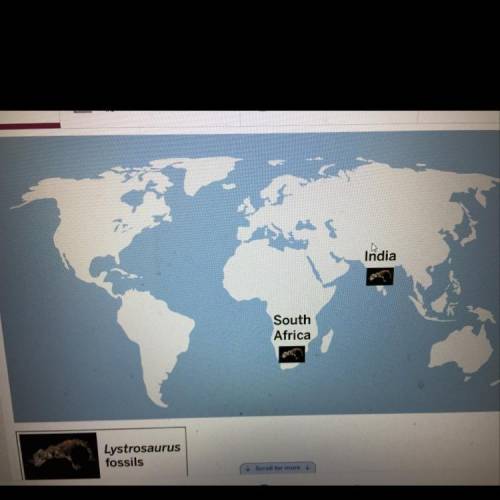
Biology, 23.03.2020 15:59, amortegaa805
Fossil remains of Lustrosaurus (an extinct four-legged animal) have been discovered in India and
South Africa. When they were living, all the Lystrosaurus lived together on land, and they could not
swim. However, now there is an ocean between the Lystrosaurus fossils. What could explain how
these fossils got so far apart?
A. India and South Africa are parts of different plates. The plates slowly moved far apart as
soft, solid rock from underneath got added to the edges of the plates over millions of years.
B. India and South Africa are parts of different plates. The plates floated away from each other
across the ocean.
C. India and South Africa are parts of different plates. The plates slowly moved apart as new
plates from underneath got added between them over millions of years.
D. India and South Africa are parts of different plates. The plates were sometimes pushed far
apart by earthquakes, and soft, solid rock from underneath got added to the edges of the
plates.


Answers: 3
Other questions on the subject: Biology

Biology, 22.06.2019 00:10, hannahkharel2
What are the formed elements (cell or parts of cell) in blood and what are their functions ?
Answers: 1

Biology, 22.06.2019 04:00, belle200163
Select the correct answer. which mutation is harmful to the organism? a. a mutation allowing moths to camouflage better on blackened tree bark b. a mutation making staphylococcus aureus resistant to the antibiotic methicillin c. a mutation inhibiting human immunodeficiency virus from attaching to and entering the cell d. a mutation causing uncontrolled cell division e. a mutation giving plant leaves a bitter taste to discourage herbivores from eating them
Answers: 1

Biology, 22.06.2019 15:30, perezsamantha3oqr0za
The image shows a group of fish. the type of social behavior shown in the image is called
Answers: 2

Biology, 22.06.2019 19:00, katherineweightman
1. in what ways have non-native species been beneficial? 2. what are some of the hypotheses for the collapse of honeybee colonies? 3. distinguish between regional and functional extinction. 4. why is it difficult to measure background extinction rates? 5. what three factors are most important in causing extinction rates to climb?
Answers: 2
Do you know the correct answer?
Fossil remains of Lustrosaurus (an extinct four-legged animal) have been discovered in India and
Questions in other subjects:



Mathematics, 06.06.2020 10:57

Mathematics, 06.06.2020 10:57

Health, 06.06.2020 10:57


Computers and Technology, 06.06.2020 10:57

English, 06.06.2020 10:57

Physics, 06.06.2020 10:57

Mathematics, 06.06.2020 10:57






